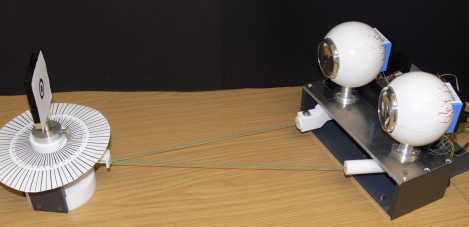Roundabout 1.3 billion people worldwide suffer from age-related hyperopia. From the age of 40, close vision deteriorates, because the eye is no longer able to image objects in closest proximity sharply. This is due to the reduced elasticity of the lens. Scientists of the Karlsruhe Institute of Technology (KIT) are currently developing an intelligent implant to alleviate this phenomenon.
If the length of an arm is no longer sufficient to read the newspaper, reading glasses normally help to compensate reduced acuity of vision. Scientists from the Institute for Applied Computer Science (IAI) now want to transfer this service into the eye and restore the continuous refraction power of the lens by an intelligent system. The vision of the scientists: An optics with intelligent materials that adapts to the varying conditions of close and far vision. “Within a period of five years, we want to develop a prototype and create the prerequisites for an implant”, announces Professor Georg Bretthauer from the IAI.
The human eye is an optical system. It deflects incident light on its way from the cornea to the retina on the back of the eye such that a sharp image of the object sighted is created on the retina. The eye has to adapt its refraction power to objects at varying distances. To do this, the ciliary muscle changes the shape and position of the eye’s lens. When looking at an object in the distance, the lens has a flatter shape and, consequently, a lower refraction power. The closer the object is moved, the more does the lens assume a spherical shape with an increased refraction power. This is called accommodation and means an adaptation to varying visual ranges. Accommodation decreases over the years and disappears nearly completely in the case of age-related hyperopia, because the lens loses its elasticity.
The artificial accommodation system developed by the KIT scientists is supposed to compensate the reduced visual capacity. For this purpose, it requires several components: An active optical element with an actuator system, a sensor for measuring the accommodation demand, and control and energy supply units. At the moment, KIT scientists are developing the fundamentals of the actuator system, energy supply system, and systems integration. As far as the other components are concerned, major results have already been obtained, which is illustrated by a demonstrator of the human eye on the scale of 5:1 (see photo).
The project is executed in close cooperation with the ophthalmic hospital of the University of Rostock. From 2009, the companies of Carl Zeiss Meditec AG and Wittenstein AG will be involved in the project as industry partners. The joint project of KIT, the University of Rostock, and these two industry partners will then be funded by the Federal Ministry of Education and Research, the objective being to develop a prototype.
The Karlsruhe Institute of Technology (KIT) is the merger of the Forschungszentrum Karlsruhe, member of the Helmholtz Association, and the Universität Karlsruhe. This merger will give rise to an institution of internationally excellent research and teaching in natural and engineering sciences. In total, the KIT has 8000 employees and an annual budget of 700 million Euros. The KIT focuses on the knowledge triangle of research – teaching – innovation.
The Karlsruhe institution is a leading European energy research center and plays a visible role in nanosciences worldwide. KIT sets new standards in teaching and promotion of young scientists and attracts top scientists from all over the world. Moreover, KIT is a leading cooperation partner of industry.

